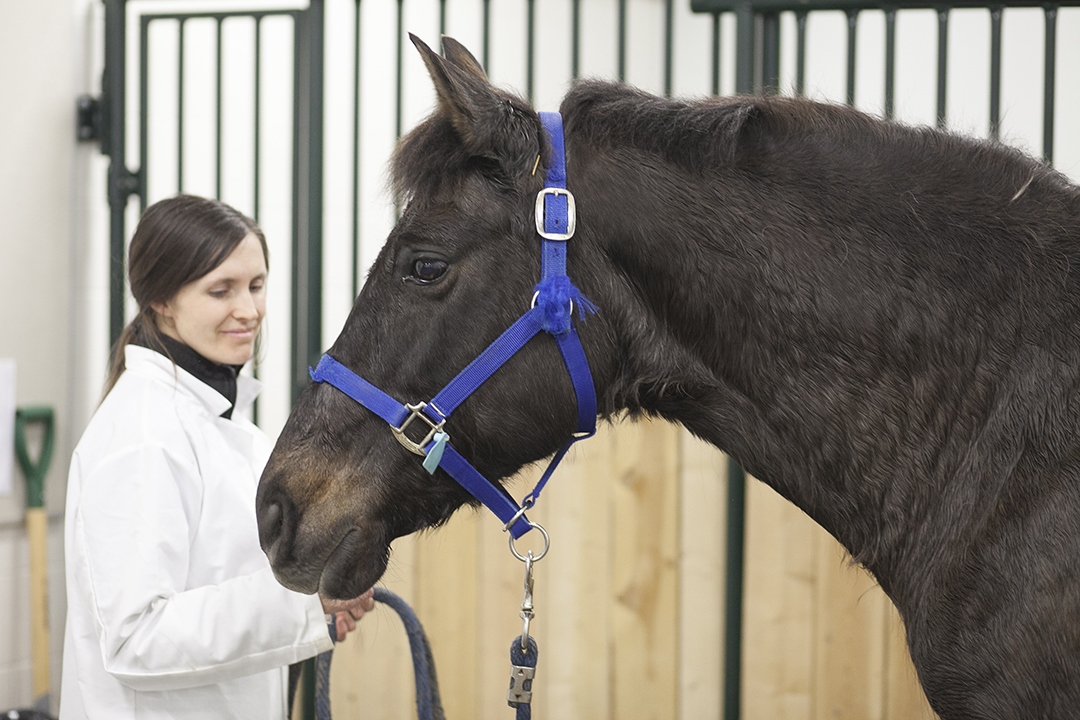
Cresty necks flag metabolic issues in horses
While University of Saskatchewan (USask) researchers are still hunting for a diagnostic biomarker that predicts equine metabolic syndrome (EMS), results of their recent study substantiated the cresty neck score (CNS) as a reliable visual marker of abnormal insulin metabolism in horses.
By Myrna MacDonaldThe study, which was published in the Journal of Equine Veterinary Science, was conducted by a team of USask scientists from the Western College of Veterinary Medicine (WCVM) and College of Pharmacy and Nutrition.
Researchers compare EMS to human type 2 diabetes because both are characterized by obesity and insulin resistance. In human metabolic syndrome and type 2 diabetes, researchers recognize methylglyoxal (MG), D-lactate and several cytokines (cell-signalling molecules) as biomarkers of important metabolic and inflammatory processes.
Biomarkers are objective medical indicators that help to measure the presence of disease or the impact of therapy.
Thirty-two client-owned horses, ranging from five to 24 years old, participated in the cross-sectional study. According to the combined glucose insulin test (CGIT), researchers classified 12 horses as insulin dysregulated (ID) while 20 of the horses were considered insulin sensitive (IS).
For each horse, the research team tested baseline serum or plasma concentrations of biomarkers using commercial ELISA or colorimetric assays (reactions that lead to a change in colour). They compared body condition score (BCS), cresty neck score (CNS), resting insulin, MG, D-lactate, L-lactate, tumour necrosis factor-α (TNF-α), interleukin-6 (IL-6) and monocyte che-moattractant protein-1 (MCP-1) between horses with and without ID.
Researchers found no significant difference between the two groups in relation to age, BCS, baseline glucose, triglycerides, MG, D-lactate, L-lactate and cytokines. Overall, the USask team determined that horses with mild to moderate signs of EMS presented similar metabolic and inflammatory profiles to horses with no signs of ID.
However, the study’s results did confirm cresty necks as a reliable visual sign of abnormal insulin metabolism in horses. Among the 32 horses, animals with CNS of 3 and higher (on a scale of 0 to 5) were more than 11 times as likely to have ID. In this study, cresty neck scores were also much stronger predictors of ID than general obesity.
Fat deposits along the crest or upper curve of a horse’s neck tend to develop in ponies and other breeds such as Morgan, Peruvian Paso, Andalusian and Arabian horses. While these breeds are known to be more prone to ID and EMS, this study showed that quarter horses can also exhibit cresty necks and ID.
While other researchers have previously associated cresty neck scores with laminitis and potential signs of ID, this study represents the first time that the visual indicator has been statistically associated with abnormal CGIT results.
The study’s findings stress the importance of client education in monitoring their horses’ body condition. Owners need to regularly observe horses for deviations from their ideal weight, especially looking for cresty necks and other localized fat deposits. Previous research has shown that owners tend to underestimate their horses’ body condition and fat distribution, so increased owner awareness can lead to early screening and timely management of ID.
Researchers recommend that more work should be done to identify a diagnostic marker for early EMS. They also hope to characterize the different stages of insulin dysregulation so veterinarians and owners can implement management changes as early as possible.
One of the study’s strengths was the variety of its subjects: the client-owned horses represent a wide range of animals in various stages of obesity and insulin dysregulation. The USask team suggested that the equine research community should approach EMS as a spectrum (like equine asthma) versus treating the disease as a constant state.
The Townsend Equine Health Research Fund (TEHRF) provided funding for this project.
